Economics Report: Classification, Linkages, and Outlook of EU Economy
VerifiedAdded on 2023/04/21
|5
|869
|357
Report
AI Summary
This report provides an overview of the European Union's economy, starting with a classification based on geographical area, GDP, and per capita GDP. It then explores the strong economic ties between the U.S. and the EU, highlighting trade and investment relationships. The report also discusses measures taken by EU members to mitigate current economic problems, such as the creation of the European Financial Stability mechanism and initiatives to manage migration. Finally, it analyzes the economic outlook for EU nations, considering factors like Brexit and its potential impact on trade and macroeconomic indicators. The report draws on various sources to support its analysis, including official EU publications and academic research.
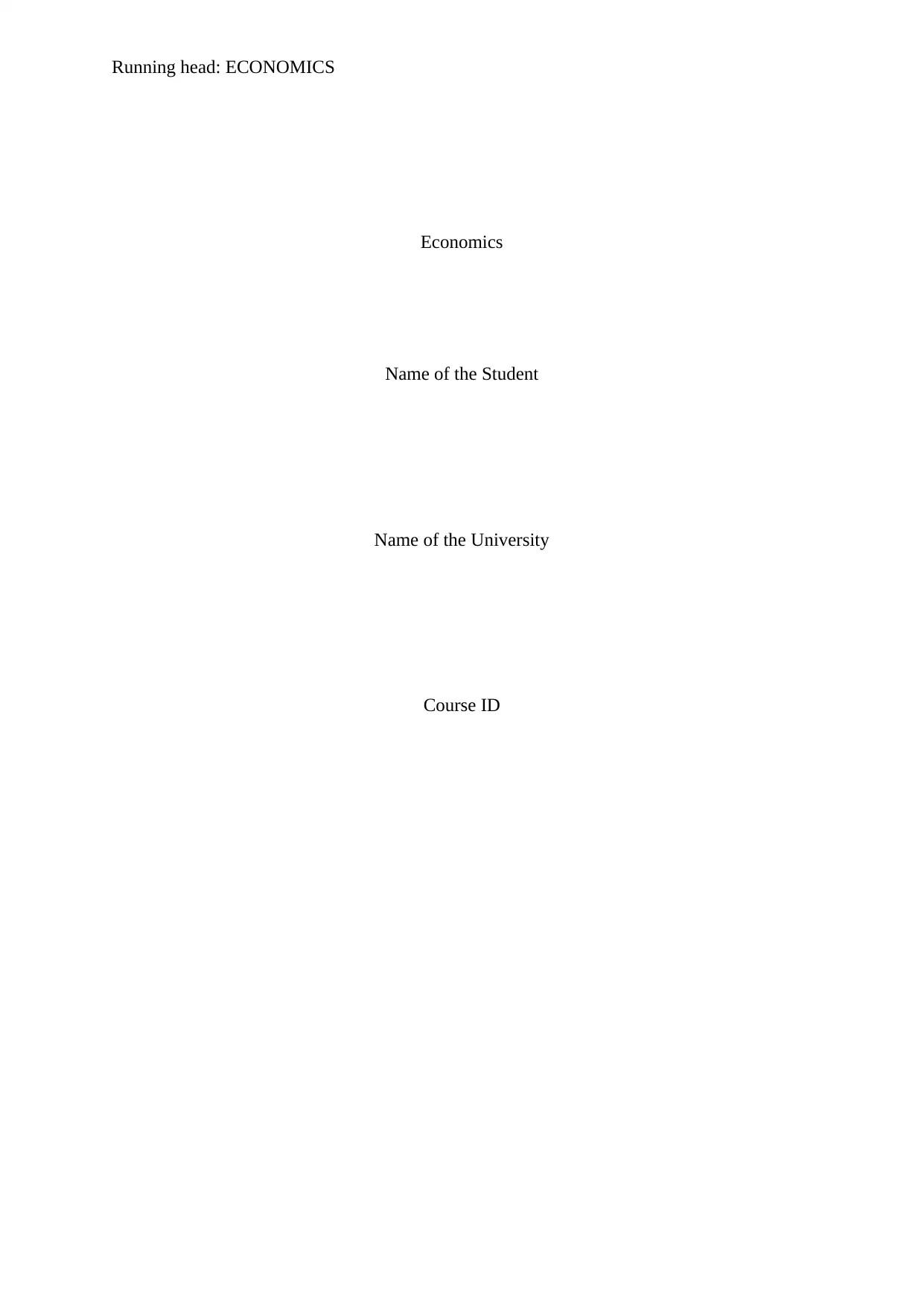
Running head: ECONOMICS
Economics
Name of the Student
Name of the University
Course ID
Economics
Name of the Student
Name of the University
Course ID
Paraphrase This Document
Need a fresh take? Get an instant paraphrase of this document with our AI Paraphraser
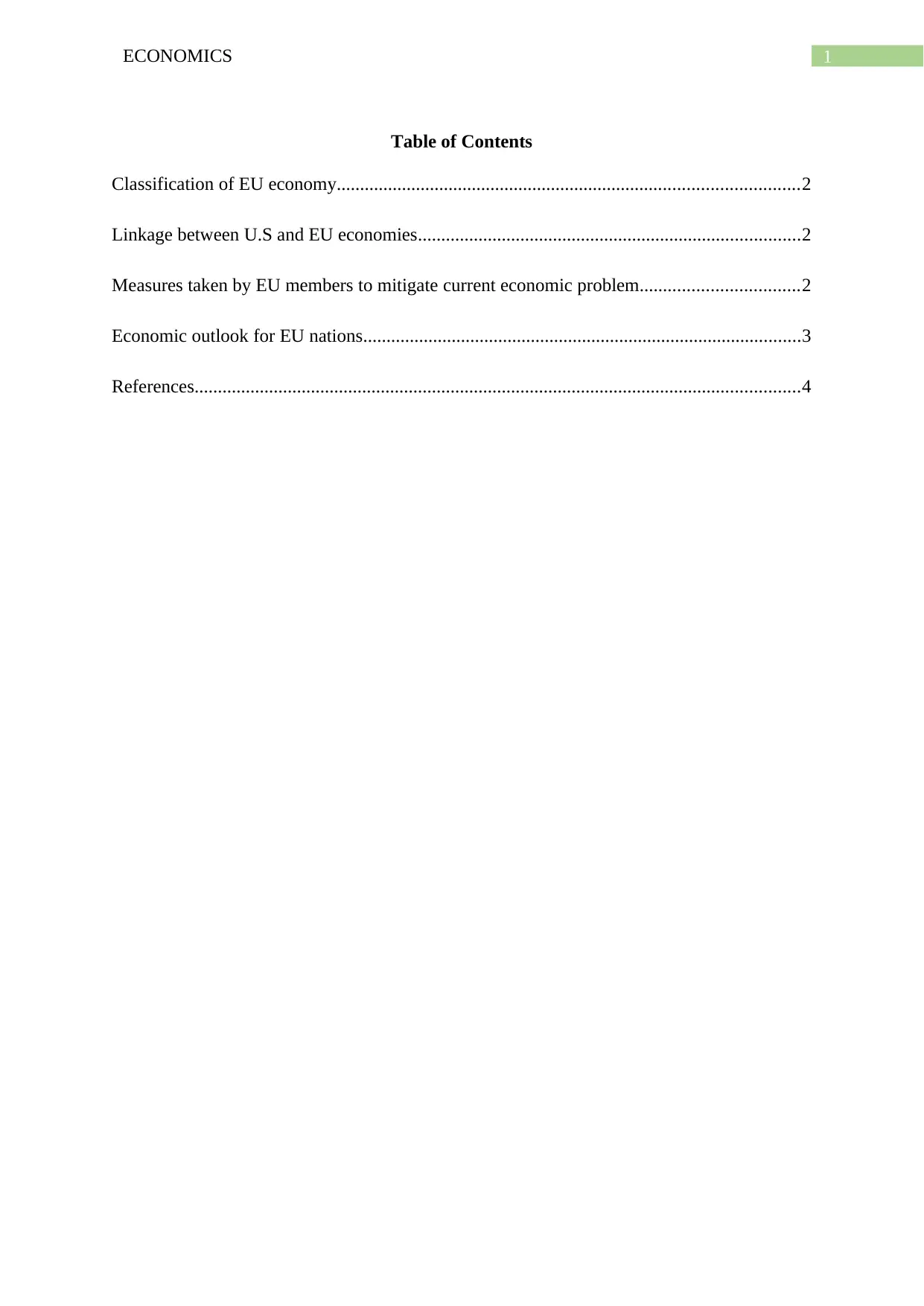
1ECONOMICS
Table of Contents
Classification of EU economy...................................................................................................2
Linkage between U.S and EU economies..................................................................................2
Measures taken by EU members to mitigate current economic problem..................................2
Economic outlook for EU nations..............................................................................................3
References..................................................................................................................................4
Table of Contents
Classification of EU economy...................................................................................................2
Linkage between U.S and EU economies..................................................................................2
Measures taken by EU members to mitigate current economic problem..................................2
Economic outlook for EU nations..............................................................................................3
References..................................................................................................................................4
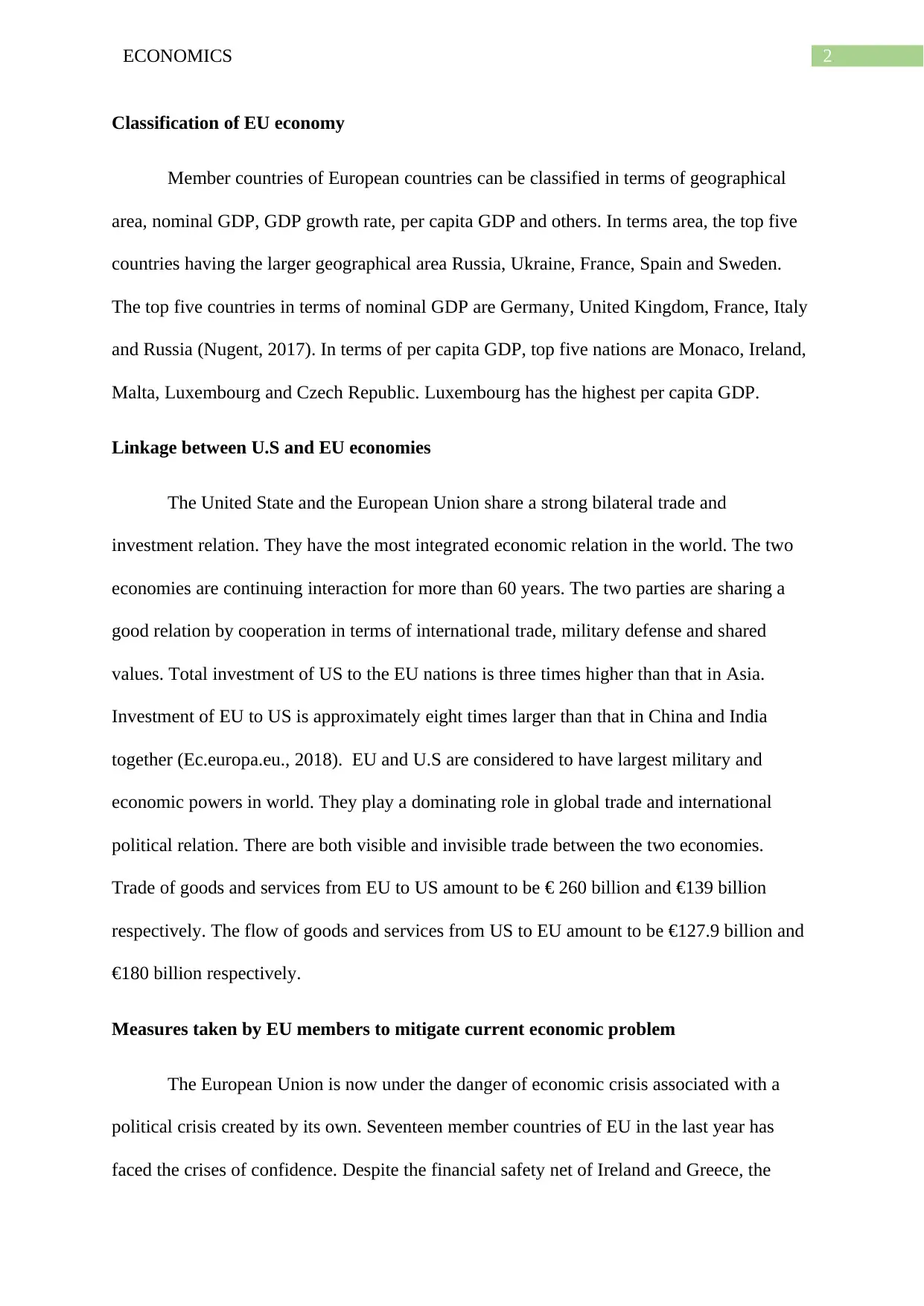
2ECONOMICS
Classification of EU economy
Member countries of European countries can be classified in terms of geographical
area, nominal GDP, GDP growth rate, per capita GDP and others. In terms area, the top five
countries having the larger geographical area Russia, Ukraine, France, Spain and Sweden.
The top five countries in terms of nominal GDP are Germany, United Kingdom, France, Italy
and Russia (Nugent, 2017). In terms of per capita GDP, top five nations are Monaco, Ireland,
Malta, Luxembourg and Czech Republic. Luxembourg has the highest per capita GDP.
Linkage between U.S and EU economies
The United State and the European Union share a strong bilateral trade and
investment relation. They have the most integrated economic relation in the world. The two
economies are continuing interaction for more than 60 years. The two parties are sharing a
good relation by cooperation in terms of international trade, military defense and shared
values. Total investment of US to the EU nations is three times higher than that in Asia.
Investment of EU to US is approximately eight times larger than that in China and India
together (Ec.europa.eu., 2018). EU and U.S are considered to have largest military and
economic powers in world. They play a dominating role in global trade and international
political relation. There are both visible and invisible trade between the two economies.
Trade of goods and services from EU to US amount to be € 260 billion and €139 billion
respectively. The flow of goods and services from US to EU amount to be €127.9 billion and
€180 billion respectively.
Measures taken by EU members to mitigate current economic problem
The European Union is now under the danger of economic crisis associated with a
political crisis created by its own. Seventeen member countries of EU in the last year has
faced the crises of confidence. Despite the financial safety net of Ireland and Greece, the
Classification of EU economy
Member countries of European countries can be classified in terms of geographical
area, nominal GDP, GDP growth rate, per capita GDP and others. In terms area, the top five
countries having the larger geographical area Russia, Ukraine, France, Spain and Sweden.
The top five countries in terms of nominal GDP are Germany, United Kingdom, France, Italy
and Russia (Nugent, 2017). In terms of per capita GDP, top five nations are Monaco, Ireland,
Malta, Luxembourg and Czech Republic. Luxembourg has the highest per capita GDP.
Linkage between U.S and EU economies
The United State and the European Union share a strong bilateral trade and
investment relation. They have the most integrated economic relation in the world. The two
economies are continuing interaction for more than 60 years. The two parties are sharing a
good relation by cooperation in terms of international trade, military defense and shared
values. Total investment of US to the EU nations is three times higher than that in Asia.
Investment of EU to US is approximately eight times larger than that in China and India
together (Ec.europa.eu., 2018). EU and U.S are considered to have largest military and
economic powers in world. They play a dominating role in global trade and international
political relation. There are both visible and invisible trade between the two economies.
Trade of goods and services from EU to US amount to be € 260 billion and €139 billion
respectively. The flow of goods and services from US to EU amount to be €127.9 billion and
€180 billion respectively.
Measures taken by EU members to mitigate current economic problem
The European Union is now under the danger of economic crisis associated with a
political crisis created by its own. Seventeen member countries of EU in the last year has
faced the crises of confidence. Despite the financial safety net of Ireland and Greece, the
⊘ This is a preview!⊘
Do you want full access?
Subscribe today to unlock all pages.

Trusted by 1+ million students worldwide
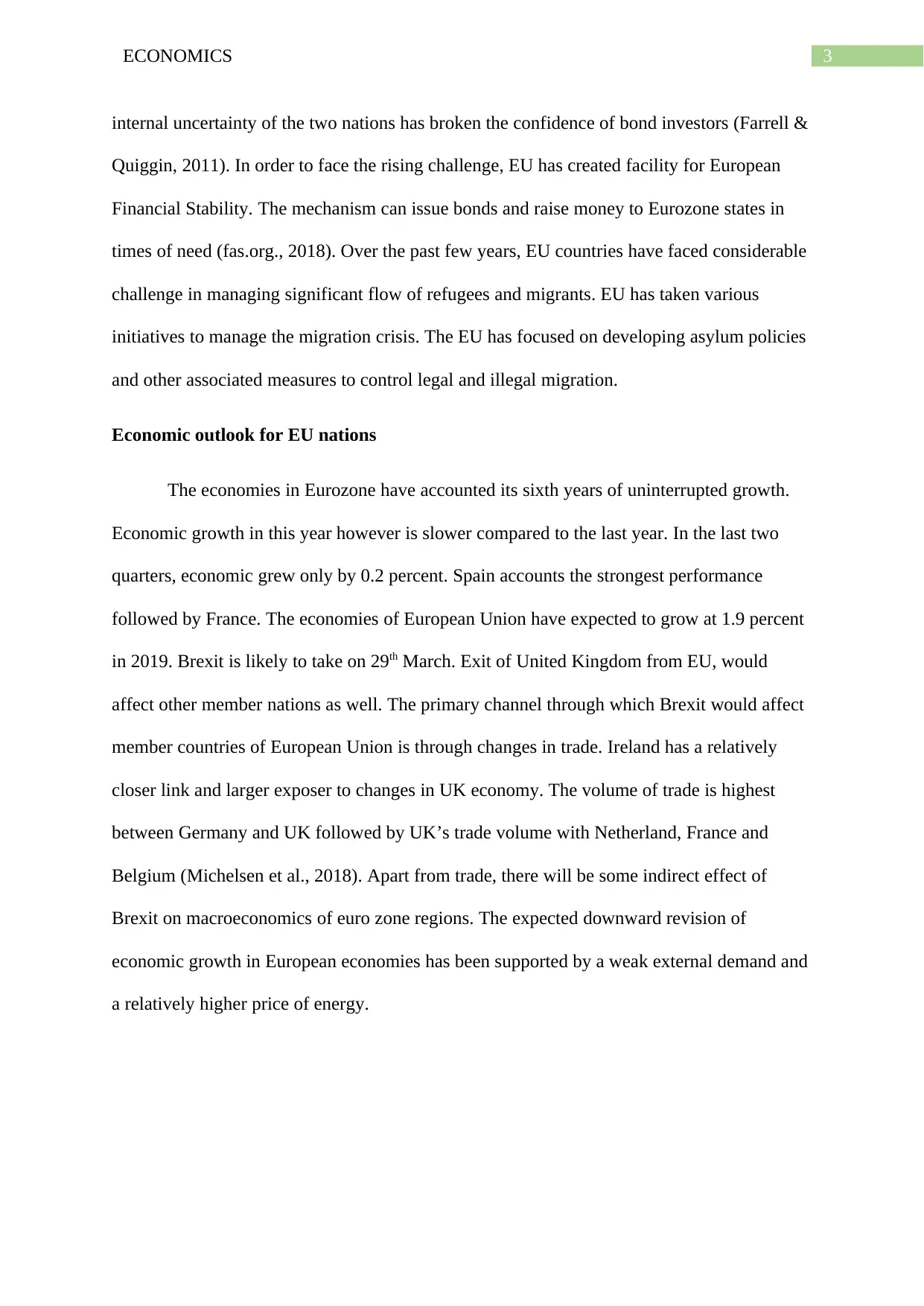
3ECONOMICS
internal uncertainty of the two nations has broken the confidence of bond investors (Farrell &
Quiggin, 2011). In order to face the rising challenge, EU has created facility for European
Financial Stability. The mechanism can issue bonds and raise money to Eurozone states in
times of need (fas.org., 2018). Over the past few years, EU countries have faced considerable
challenge in managing significant flow of refugees and migrants. EU has taken various
initiatives to manage the migration crisis. The EU has focused on developing asylum policies
and other associated measures to control legal and illegal migration.
Economic outlook for EU nations
The economies in Eurozone have accounted its sixth years of uninterrupted growth.
Economic growth in this year however is slower compared to the last year. In the last two
quarters, economic grew only by 0.2 percent. Spain accounts the strongest performance
followed by France. The economies of European Union have expected to grow at 1.9 percent
in 2019. Brexit is likely to take on 29th March. Exit of United Kingdom from EU, would
affect other member nations as well. The primary channel through which Brexit would affect
member countries of European Union is through changes in trade. Ireland has a relatively
closer link and larger exposer to changes in UK economy. The volume of trade is highest
between Germany and UK followed by UK’s trade volume with Netherland, France and
Belgium (Michelsen et al., 2018). Apart from trade, there will be some indirect effect of
Brexit on macroeconomics of euro zone regions. The expected downward revision of
economic growth in European economies has been supported by a weak external demand and
a relatively higher price of energy.
internal uncertainty of the two nations has broken the confidence of bond investors (Farrell &
Quiggin, 2011). In order to face the rising challenge, EU has created facility for European
Financial Stability. The mechanism can issue bonds and raise money to Eurozone states in
times of need (fas.org., 2018). Over the past few years, EU countries have faced considerable
challenge in managing significant flow of refugees and migrants. EU has taken various
initiatives to manage the migration crisis. The EU has focused on developing asylum policies
and other associated measures to control legal and illegal migration.
Economic outlook for EU nations
The economies in Eurozone have accounted its sixth years of uninterrupted growth.
Economic growth in this year however is slower compared to the last year. In the last two
quarters, economic grew only by 0.2 percent. Spain accounts the strongest performance
followed by France. The economies of European Union have expected to grow at 1.9 percent
in 2019. Brexit is likely to take on 29th March. Exit of United Kingdom from EU, would
affect other member nations as well. The primary channel through which Brexit would affect
member countries of European Union is through changes in trade. Ireland has a relatively
closer link and larger exposer to changes in UK economy. The volume of trade is highest
between Germany and UK followed by UK’s trade volume with Netherland, France and
Belgium (Michelsen et al., 2018). Apart from trade, there will be some indirect effect of
Brexit on macroeconomics of euro zone regions. The expected downward revision of
economic growth in European economies has been supported by a weak external demand and
a relatively higher price of energy.
Paraphrase This Document
Need a fresh take? Get an instant paraphrase of this document with our AI Paraphraser
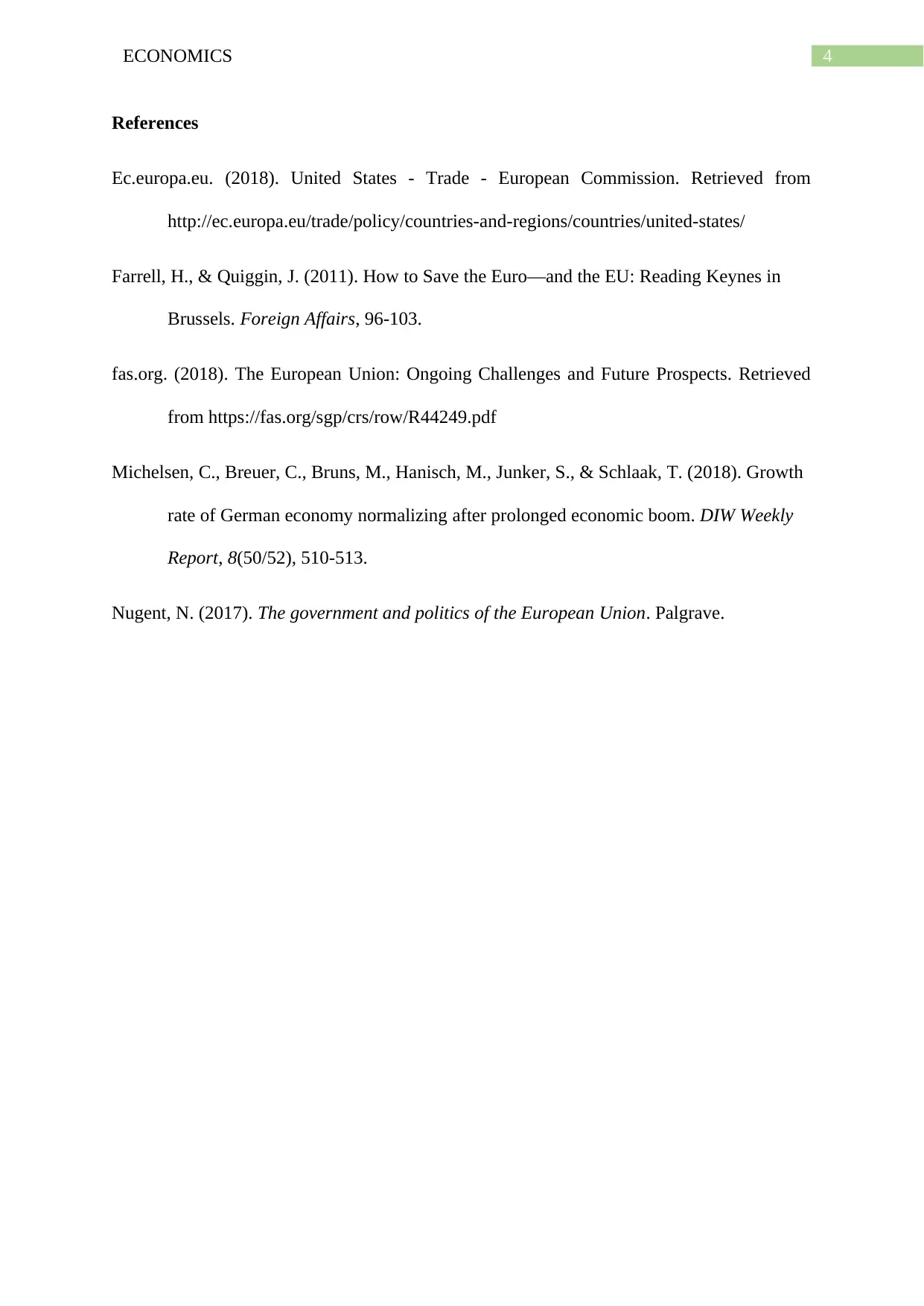
4ECONOMICS
References
Ec.europa.eu. (2018). United States - Trade - European Commission. Retrieved from
http://ec.europa.eu/trade/policy/countries-and-regions/countries/united-states/
Farrell, H., & Quiggin, J. (2011). How to Save the Euro—and the EU: Reading Keynes in
Brussels. Foreign Affairs, 96-103.
fas.org. (2018). The European Union: Ongoing Challenges and Future Prospects. Retrieved
from https://fas.org/sgp/crs/row/R44249.pdf
Michelsen, C., Breuer, C., Bruns, M., Hanisch, M., Junker, S., & Schlaak, T. (2018). Growth
rate of German economy normalizing after prolonged economic boom. DIW Weekly
Report, 8(50/52), 510-513.
Nugent, N. (2017). The government and politics of the European Union. Palgrave.
References
Ec.europa.eu. (2018). United States - Trade - European Commission. Retrieved from
http://ec.europa.eu/trade/policy/countries-and-regions/countries/united-states/
Farrell, H., & Quiggin, J. (2011). How to Save the Euro—and the EU: Reading Keynes in
Brussels. Foreign Affairs, 96-103.
fas.org. (2018). The European Union: Ongoing Challenges and Future Prospects. Retrieved
from https://fas.org/sgp/crs/row/R44249.pdf
Michelsen, C., Breuer, C., Bruns, M., Hanisch, M., Junker, S., & Schlaak, T. (2018). Growth
rate of German economy normalizing after prolonged economic boom. DIW Weekly
Report, 8(50/52), 510-513.
Nugent, N. (2017). The government and politics of the European Union. Palgrave.
1 out of 5
Related Documents
Your All-in-One AI-Powered Toolkit for Academic Success.
+13062052269
info@desklib.com
Available 24*7 on WhatsApp / Email
![[object Object]](/_next/static/media/star-bottom.7253800d.svg)
Unlock your academic potential
Copyright © 2020–2025 A2Z Services. All Rights Reserved. Developed and managed by ZUCOL.





